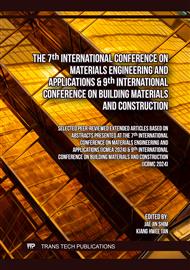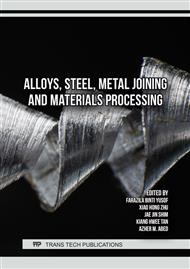[1]
J. Vollmar, E. Roeder: Werkstoffe und Korrosion Vol. 45 (1994), p.444–451
Google Scholar
[2]
Y.B. Unigovski, G. Lothongkum, E.M. Gutman, D. Alush, R. Cohen R: Corros. Sci. Vol. 51 (2009), p.3014–3020
DOI: 10.1016/j.corsci.2009.08.035
Google Scholar
[3]
C.M. Holtam, D.P. Baxter, I.A. Ashcroft, R.C. Thomson: Int. J. Fatigue Vol. 32 (2010) p.288–296
Google Scholar
[4]
I. Thorbjörnsson: Mater. Des. Vol. 16 (1995), p.97–102
Google Scholar
[5]
J.P. Thomas, R.P Wei: Mater. Sci. Eng. A Vol. 159 (1992) p.205–221
Google Scholar
[6]
R. Ebara: Eng. Fail. Anal. Vol. 13 , (2006), p.516–525
Google Scholar
[7]
I. Alvarez-Armas: Mech. Eng. Vol. 1 (2008) 51–57
Google Scholar
[8]
T. Prosek et al.: Corrosion Vol. 70 (2014), p.1052–1063
Google Scholar
[9]
S. Schultze, J. Göllner, K. Eick, P. Veit, H. Heyse: Mater. Corros. Vol. 52 (2001) p.26–36
Google Scholar
[10]
N. Arnold, P. Gümpel, T.W. Heitz: Mater. Corros. Vol. 49 (1999) p.140–145
Google Scholar
[11]
M. Wolf et al.: Energy Procedia Vol. 114 (2017), p.5337 – 5345
Google Scholar
[12]
A. Pfennig, A. Gröber, R. Simkin, A. Kranzmann: Matter: Int. J. Sci. and Tech. Vol. 5 (1) (2019), pp.609-631
Google Scholar
[13]
A. Pfennig, A. Kranzmann: Int. J. of Materials Sci. and Eng. IJMSE Vol.7(2)(2019), pp.26-33
Google Scholar
[14]
A. Pfennig, M. Wolf: Journal of Physics: Conf. Series JPCS Vol. 1425 (2019) Paper No. 012183
Google Scholar
[15]
A. Pfennig, M. Wolf: IOP Conf. Ser.: Mater. Sci. Eng. Vol. 894 012015 (2020), pp.93-98.
Google Scholar
[16]
A.M. Elhoud, N.C. Renton, W.F. Deans: Int. J. of Hydrogen Energy Vol. 35 (12) 2010, p.6455–6464
DOI: 10.1016/j.ijhydene.2010.03.056
Google Scholar
[17]
H. Luo, C.F. Dong, Z.Y. Liu, M.T.J. Maha, X.G. Li XG (2013) Materials and Corrosion 64 (1) 26–33
Google Scholar
[18]
A. Pfennig, M. Wolf: Key Engineering Materials KEM Vol. 929 (2022), pp.35-40
Google Scholar
[19]
J. Lv, W. Guo, T. Liang: Journal of Alloys and Compounds Vol. 686 (2016), pp.176-183
Google Scholar
[20]
A. Förster et al.: Mar. Pet. Geol. Vol. 27 (2010), p.2156–2172
Google Scholar
[21]
W. Luu, P. Liu, J. Wu: Corr. Sci. Vol. 44 (8) (2002), p.1783–1791
Google Scholar
[22]
C. San Marchi, B.P. Somerday, J. Zelinski, X. Tang, G.H. Schiroky: Metallurgical and Materials Transactions A: Physical Metallurgy and Materials Science Vol. 38 A (11) (2007), p.2763–2775
DOI: 10.1007/s11661-007-9286-3
Google Scholar
[23]
K. Makhlouf, H. Sidhom, I. Triguia, C. Braham: International Journal of Fatigue Vol. 25 (2) (2003), p.167–179
Google Scholar
[24]
H.G. Nelson: In: Treatise on Materials Science and Technology: Embrittlement of Engineering Alloys Vol. 25, edited by C.L. Briant, S.K. Banerji (1983) Academic Press Inc. p.275–359
Google Scholar
[25]
C.D. Beachem: Metallurgical Transactions B Vol. 3 (2) (1972), p.441–455
Google Scholar
[26]
H. Birnbaum, P. Sofronis: Materials Science and Engineering A Vol.176(1-2) (1994), pp.191-202
Google Scholar
[27]
A. Pfennig, A. Gröber, R. Simkin, A. Kranzmann: (2019) Available at SSRN: https://ssrn.com/abstract=3365580
Google Scholar
[28]
E. Owczarek, T. Zakroczymski: Acta Materialia Vol. 48 (12) (2000), pp.3059-3070
DOI: 10.1016/s1359-6454(00)00122-1
Google Scholar
[29]
A. Turnbull, E. Lembach-Beylegaard, R.B. Hutchings: In: Fourth International Conference Duplex Stainless Steels, Glasgow, edited by S. Scotland, Materials Technology Manager TWI, (1994) Paper 80
Google Scholar
[30]
H.H. Lee, H.H. Uhlig: Metallurgical Transactions Vol. 3 (11) (1972), p.949–2957.
Google Scholar



